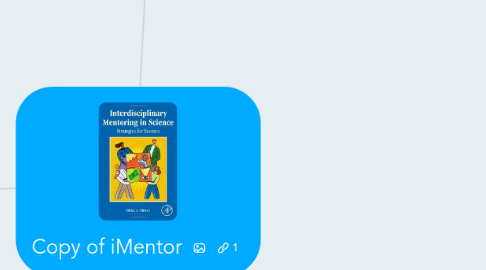
1. SciTS
1.1. 1.a group of interconnected elements, formed by the interaction of a community of organisms with their environment.
1.2. Ecosystem:
1.2.1. Landscape
1.2.1.1. Changes in Research Styles
1.2.1.2. From “Silo” scientists need to move to interdisciplinary teams
1.2.2. Opportunity
1.2.2.1. New venues
1.2.2.2. Learning new languages
1.2.2.3. New tools for communication
1.2.2.4. New disciplines to explore
1.2.2.5. New ways to share the work load
1.2.2.6. New modalities on how to share findings
1.2.2.7. Novel way to share the recognition
1.2.3. Collaboration
1.2.3.1. Interdisciplinary
1.2.3.2. Multidisciplinary
1.2.3.3. Transdisciplinary
1.2.3.4. Intellectually challenging
1.2.3.4.1. New frame of mind
1.3. 2. Any system or network of interconnecting and interacting parts.
2. Participants
2.1. Dr. Ofelia Olivero
2.1.1. SciTS & Mentoring: role of the iMentor
2.2. John
2.2.1. Collaboration in practice: role models, use cases & tools
2.3. Andrea
2.3.1. Facilitator
2.3.1.1. Q/A
3. Mentoring Matters
3.1. Knowledge Transfer
3.1.1. Mentor
3.1.1.1. Mentee
3.1.2. How can KM and information systems re-appropriate research from complex adaptive systems to inform system design, organizational design, and governance practices that foster improved knowledge transfer?
3.2. Knowledge Management
3.2.1. Academic Maturity
3.2.1.1. First, there is a trend toward higher cooperation among academics; i.e, drop in single-authored publications.
3.2.1.2. Second, the role of practitioners has changed
3.2.1.3. Their contribution to academic research has been dramatically declining from 30% of overall contributions up to 2002, to only 10% by 2009
3.2.1.3.1. information systems,
3.2.1.3.2. management
3.2.1.3.3. strategy perspectives
3.2.1.3.4. organizational Learning
3.3. Innovation Process
3.3.1. Types of Innovation
3.3.1.1. Disruptive
3.3.1.2. Sustaining
3.3.1.3. Diffusion
4. Goals
4.1. Aspire to
4.1.1. Mentor
4.1.1.1. Mentor by the example
4.1.1.2. Be a role model
4.1.1.3. Learn how to communicate
4.1.1.4. Master the cultures
4.1.1.5. Master the languages
4.1.1.6. Blend
4.1.1.7. Embrace diversity
4.2. Seek to
4.2.1. Mentee
4.2.1.1. Learn how to communicate
4.2.1.2. Listen, Listen, Listen
4.2.1.3. Felxibilize your brain
4.2.1.4. Be comfortable sharing
4.3. How to
4.3.1. Leverage Diversity & Inclusion
4.3.1.1. Change in process and culture
4.3.1.1.1. Change management iniatives
4.3.1.1.2. Organizational development
4.3.1.2. Employee engagement
4.3.1.2.1. Retention
4.3.1.2.2. Performance management
4.3.1.2.3. Human capital / workforce planning
4.3.1.2.4. Compensation/ Grants
4.3.1.3. Brand advocates & ambassadors
4.3.1.3.1. Build customer & brand loyalty
4.3.1.3.2. Recruitment
4.3.1.3.3. Corporate social responsibility
4.3.1.4. Career and professional development
4.3.1.4.1. Individual development programs
4.3.1.4.2. Interdisciplinary collaboration
4.3.1.5. Stakeholder engagement
4.3.1.5.1. Value creation
4.3.1.5.2. Strategic partnerships
4.3.1.6. To drive performance and innovation
5. Agenda
5.1. SicTS
5.2. Why Mentoring Matters
5.3. Role of the iMentor
5.4. Strategies for Success
6. Desired Outcomes
6.1. The iMentor
6.1.1. Understands the concept of Interdisciplinary Science
6.1.2. Exercises self-reflection
6.1.3. Learns to be open minded
6.1.4. Exercises respect and trust
6.1.5. Would be able to put himself on a side
6.1.6. Looks for common ground
6.1.7. Should be able to see the whole picture
6.1.8. Will be a potential leader if circumstances demand it
6.2. Innovation Team
6.3. A community of diverse scientists unified by mentoring connections, ready to establish collaborations and to work in an interdisciplinary fashion
6.3.1. Reward Mechanisms
6.3.2. Link to Amazon
